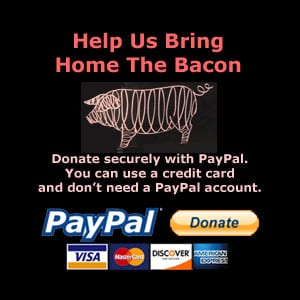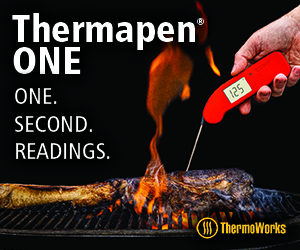In this topic:
Page 1
Page 2
- Barbecue Crawl Day 1: Franklin Barbecue
- What To Expect At Franklin Barbecue
- What To Eat At Franklin Barbecue
- Private Tour Of The Smokehouse
- How To Avoid The Line At Franklin Barbecue
- Playing Tourist In Austin: State Capitol & LBJ Presidential Library
Page 3
- Barbecue Crawl Day 2: Smitty’s Market, Black’s Barbecue, Kreuz Market, City Market
- What To Expect At Smitty’s Market
- What To Eat At Smitty’s Market
- Touring Smitty’s And Nearby Courthouse
- What To Expect At Black’s Barbecue
- What To Eat At Black’s Barbecue
- What To Expect At Kreuz Market
- What To Eat At Kreuz Market
- What To Expect At City Market
- What To Eat At City Market
- Can We Bring Ourselves To Do This Again Tomorrow?
Page 4
- Barbecue Crawl Day 3: Snow’s BBQ, Louie Mueller Barbecue
- What To Expect At Snow’s BBQ
- What To Eat At Snow’s BBQ
- What To Expect At Louie Mueller Barbecue
- What To Eat At Louie Mueller Barbecue
- There’s Always Room For A Donut
- Departing Austin
- Summary Of The Best Meats
- Resources For Your Central Texas Barbecue Crawl
What Is A Barbecue Crawl?
A barbecue crawl is inspired by the bar crawl or pub crawl, in which people move from bar to bar, usually on foot, usually in a single night, to enjoy a drink at each establishment. Unlike a bar crawl, a barbecue crawl is usually spread out over several days, driving from one restaurant to the next, sampling barbecue as you go.
Why Crawl Central Texas Barbecue Joints?
You probably know that the four most well-known regional styles of barbecue in the United States are the Carolinas, Kansas City, Memphis, and Texas. You may also know that Texas barbecue is not a single style. According to Daniel Vaughn, barbecue editor at Texas Monthly magazine and author of the excellent book The Prophets of Smoked Meat: A Journey Through Texas Barbecue, there are four main styles of Texas barbecue that represent the geographic and historical diversity of the state:
- Hill Country Style: Cooking hot & fast over direct heat from mesquite coals. Typical meats include brisket, beef ribs, chicken, turkey, and goat. Not a lot of smoky flavor. Also known as West Texas-style or cowboy-style barbecue.
- East Texas Style: The roots of this style came with slaves who left the Deep South and settled in East Texas. Fall-off-the-bone tender beef (usually chopped, not sliced), ribs, beef hot links, and pork sausage are the common meats, served with a thick, sweet sauce. Hickory wood is the common fuel source. This style is typical in Texas urban centers and suburbs.
- South Texas Style: Brisket, ribs, and sausage are the mainstays here, served with molasses-like sauces, but the highlight is barbacoa—whole cow heads cooked slowly until the meat falls off the skull—served with tortillas and salsa. Historically, skulls were wrapped in banana leaves or other large leaves and cooked in a covered pit in the ground. Today they’re wrapped in aluminum foil and cooked in ovens until tender.
- Central Texas Barbecue: Cooking meat low and slow over a post oak or pecan wood fire is the name of the game with this style. Beef is the main attraction—brisket, beef ribs, and short ribs seasoned simply with salt and pepper, along with all manner of beef sausages—but pork ribs, pork loin, chicken, turkey and other meats are commonly available. Sauce is all over the map, but commonly it’s tomato-based, thin, and a little sweet with a little heat…and when available (some restaurants like Kreuz Market don’t offer sauce) it’s served on the side as a condiment.
While each of these styles is worthy of its own barbecue crawl, a Central Texas crawl is at the top of most people’s list because the area has the highest concentration of great barbecue restaurants in the state, many in Austin and within a 50 mile radius of the city. This makes planning and executing a barbecue-oriented vacation easy, with the added bonus of other interesting attractions in Austin to round-out your trip, including a visit to the Texas State Capitol, the Lyndon B. Johnson Presidential Library, the hip Congress Avenue shopping and dining district, tons of outdoor activities, and over 250 live music venues.
Why so much good barbecue in Central Texas? The area has historically been cattle country, and the large influx of German immigrants to the area in the early 1900s brought with them the tradition of butchery and sausage making. They established small grocery stores and meat markets selling staple goods, produce and fresh meat and sausage, then smoked the leftover meat and sold it by the pound for lunch the next day. These markets faded away with the advent of modern supermarkets, but a few like Kreuz Market were able to transition into barbecue restaurants.
Today, Central Texas barbecue is growing stronger every day. It lives on in people like Wayne Mueller (Louie Mueller Barbecue), Nina Sells (Smitty’s Market) and Keith Schmidt (Kreuz Market) who are carrying on their multi-generation family businesses, and it finds new expression in relative newcomers like Aaron Franklin (Franklin Barbecue) and John Lewis (La Barbecue) who are blazing new barbecue trails inspired by the old traditions.
Tips For Planning Your Central Texas Barbecue Crawl
Here are some essential tips for planning the perfect Central Texas barbecue trip.
- Review the resources listed on Page 4 at the end of this article. I’ve listed some helpful websites, smartphone apps, books, magazines and videos to help you learn more about Central Texas barbecue and to plan your trip. Click here to jump to the resources list.
- Do your homework and develop an itinerary. In advance of your visit, determine which restaurants you will visit each day and in what order. If you plan on visiting the most popular restaurants like Franklin Barbecue, do you research on which days of the week have the shortest and longest lines, and how early you should arrive to get in line. Note the address of each restaurant and use a tool like Google Maps to determine the distance, driving time, and best route to each location. You can even use Google Map’s “My Maps” feature to create your own custom barbecue crawl map with each location pinned on the map.
- Check the days and hours of operation. Some joints are closed on Sundays or Mondays, and Snow’s BBQ is famously open only on Saturdays. Many joints open at 10:00-11:00 am and close when they run out of meat, usually by mid-afternoon.
- You’ll get the best barbecue at lunch time. Many restaurants are cooking barbecue overnight so it’s ready to serve for lunch at 11:00 am—and that’s when the meat is at its best. If you show up at 3:00 pm, not only will you be stuck with leftovers, but it won’t be fresh and moist. Even some of the bigger restaurants with established lunch and dinner service are barbecuing meat only once a day and holding it at temperature for dinner, so visiting at lunchtime should get you the best meat.
- Pace your itinerary. For me, visiting three BBQ joints in a single day is about the most I can enjoy. On one day, we tried visiting four joints, and by the time we got to the fourth location, I really didn’t feel like eating any more barbecue. Besides, you want to allow plenty of time to look at the pits, the buildings, the memorabilia on the walls, take lots of photos, talk to the pitmaster if they’re available, and just soak up the atmosphere of the place. Three stops in a day feels just about right.
- Taste, don’t eat. You can’t visit multiple locations in a single day and eat a full meal at each stop. The good news is that most Central Texas joints sell barbecue by the pound, so you can buy one slice of brisket, one pork rib, and one sausage link at each location to sample and compare to the other restaurants you’ve visited.
- Focus on a single restaurant when it makes sense. There are some barbecue restaurants that are so famous or that you wait so long to get into that it might make sense to build an entire day around visiting just that one restaurant. Take your time, try all the meats on the menu, order some of the side dishes, try the desserts…have a full meal and make a complete experience out of it. For us, Franklin Barbecue was this place during our Central Texas barbecue crawl…we ate so much that we were done with barbecue for the day.
- Try each restaurant’s specialty item. Do your research to understand the “don’t miss” items at each restaurant, or ask the pitmaster if they have something on the menu that they are known for. At Louie Mueller Barbecue, it’s the beef short rib. At some of the sausage joints in Elgin, it might be a certain variety of beef sausage.
- Order at the counter. At many Central Texas barbecue restaurants, you will place your order at a counter where the meat is carved in front of you and served on butcher paper or a plate. At some old-school joints, meat is ordered, carved, and paid for in a separate pit room (which keeps the dining room smoke-free) then you move into the dining room where you order and pay for sides, desserts and drinks. At other joints, meats and sides are ordered and paid for at the same counter. Some restaurants are setup cafeteria-style where you are tempted to load-up a tray with sides and desserts before ordering meat at the end of the line and paying the cashier. Not many joints offer table service, but The Salt Lick in Driftwood, TX is an example of a restaurant that does.
- Know the local terminology. Many joints offer slices of “lean brisket” and “fatty brisket”, lean being from the flat section and fatty being from the point section. “Outside meat” is the Texas term for brisket burnt ends. “Rings” are sausages tied into a circular shape. “Hot rings” are cooked, ready-to-eat and sell for a slightly higher price than “cold rings” which need to be cooked at home. “Hot gut” is a very spicy variety of beef sausage.
- Bring some cash. Most joints take credit cards, but a few are cash or local check only. Check online before you visit.
- BYOB. The Salt Lick in Driftwood, TX outside Austin does not sell beer, but encourages you to bring your own. People show up in large groups with coolers full of beer. If beer is an important part of your barbecue experience, check in advance to see if the joint sells it or if you can bring your own.
- Many condiments are free. Look for free sliced white bread, saltine crackers, pickles and raw white onion at many locations.
- Ask questions and request access. If it feels appropriate, don’t hesitate to ask the pitmaster questions about their process and equipment. Let them know you’ve travelled a long way to try their barbecue, compliment them on their product, and ask if you can take photos of their pit and backroom operation. Who knows, you might just get a private tour from the owner like we did at Smitty’s Market.
- Consider an Austin-only barbecue crawl. Most of the old, historic joints are located within a 60 minute drive of Austin, but if you are limited to Austin itself, there are many great joints in town around which you can build a strong itinerary. These include Franklin Barbecue, La Barbecue, Micklewaith Craft Meats, Stiles Switch BBQ & Brew, Freedmen’s, and John Mueller Meat Co. You’ll even find an outpost of Black’s Barbecue, one of the old-school joints from Lockhart, now located in Austin.
Planning Our Barbecue Crawl
My wife and I planned our Central Texas barbecue crawl for October 14-18, 2015. We planned to fly from San Jose to Austin on a Wednesday afternoon, visit barbecue joints on Thursday-Friday-Saturday, and fly home early Sunday morning.
A visit to Franklin Barbecue was mandatory and would be the centerpiece of our trip. We also wanted to visit Smitty’s Market, Black’s Barbecue, and Kreuz Market (pronounced “Krites”) in Lockhart; City Market in Luling (pronounced “Lou-ling”); Snow’s BBQ in Lexington; and Louie Mueller Barbecue in Taylor.
I used the “My Maps” feature of Google Maps to drop pins for each restaurant and calculate the driving times and distances between each location.
This collection of restaurants allowed us to hit the #1, #3 and #4 rated joints according to the 2013 Texas Monthly 50 Best BBQ Joints list (Franklin, Snow’s, Louie Mueller) and #33, #34 and #35 (Black’s, Kreuz, City Market).
Since Franklin Barbecue was our top priority and we’d be waiting in line for hours to get in, we decided to visit there on Day 1 and make that our only barbecue stop of the day. On Day 2 we would drive south of Austin to visit the four joints in Lockhart and Luling. On Day 3 we would drive east to visit Snow’s BBQ (only open on Saturdays) then drive back to the northwest to swing by Louie Mueller’s.
Wednesday, October 14, 2015
Arriving In Austin
We flew into Austin-Bergstrom International Airport, a nice, modern facility befitting the state capitol of Texas. One thing you will notice upon arrival is that The Salt Lick has a barbecue counter and a taco bar right there in the airport! I’m not sure how good airport barbecue is (I’ve not tried either one) but it made more sense to us to save our appetites for the crawl.
Our base of operations would be the Courtyard by Marriott on the busy I-35 corridor just south of downtown Austin. For dinner, we enjoyed the southern cooking and funky atmosphere at Threadgill’s on W. Riverside Dr. in downtown Austin, then tried to get some rest because we’d be up very early the next day to start our barbecue adventure!







